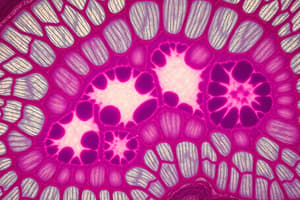Podcast
Questions and Answers
What is the primary function of the apical domain in epithelial cells?
What is the primary function of the apical domain in epithelial cells?
- Transport of ions, molecules, and water (correct)
- Cell communication
- Heat generation
- Storage of nutrients
Which of the following is NOT a structure associated with the apical domain?
Which of the following is NOT a structure associated with the apical domain?
- Mitochondria (correct)
- Cilia
- Microvilli
- Stereocilia
Where is germinal epithelium primarily found in males?
Where is germinal epithelium primarily found in males?
- In the seminiferous tubules of the testis (correct)
- In the pancreas
- In the prostate gland
- In the abdominal cavity
What do microvilli mainly enhance in epithelial cells?
What do microvilli mainly enhance in epithelial cells?
Which type of epithelium functions as sensory receptors?
Which type of epithelium functions as sensory receptors?
What structural feature distinguishes stereocilia from cilia?
What structural feature distinguishes stereocilia from cilia?
What is the primary function of the cilia in the respiratory system?
What is the primary function of the cilia in the respiratory system?
Which component is crucial for the movement of cilia through its ATPase activity?
Which component is crucial for the movement of cilia through its ATPase activity?
Kartagener's syndrome results in which of the following conditions?
Kartagener's syndrome results in which of the following conditions?
What distinguishes the basolateral domain of epithelial cells?
What distinguishes the basolateral domain of epithelial cells?
Flashcards
Germinal Epithelium
Germinal Epithelium
Epithelial cells with specialized functions, like producing sperm or ova in the testes or ovaries.
Sensory Epithelium
Sensory Epithelium
Epithelial cells that act as sensory receptors, detecting stimuli like taste, sound, or light.
Apical Domain
Apical Domain
The side of an epithelial cell facing the lumen or open space.
Microvilli
Microvilli
Signup and view all the flashcards
Epithelial Cell Polarity
Epithelial Cell Polarity
Signup and view all the flashcards
Stereocilia
Stereocilia
Signup and view all the flashcards
Cilia
Cilia
Signup and view all the flashcards
Kartagener's Syndrome
Kartagener's Syndrome
Signup and view all the flashcards
Basal Domain
Basal Domain
Signup and view all the flashcards
Basal Enfolding
Basal Enfolding
Signup and view all the flashcards
Study Notes
Epithelial Cell Polarity and Specializations
- Epithelial cells adapt structurally to perform specific functions
- Specialized forms of epithelium exhibit unique functions (e.g., germinal epithelium differentiates into sperm/ova; sensory epithelium contains receptors for taste, hearing, and vision)
- Cell membrane specializations correlate to function
- Structural abnormalities in cell membrane specialization can lead to clinical disorders
Apical Domain
- The apical domain faces the lumen
- Functions in ion transport, molecule transport, and water transport
- Contains ion channels, carrier proteins, ATPase, glycoproteins, hydrolytic enzymes, and aquaporins.
- Includes microvilli, stereocilia, cilia, and flagella (sperms)
a. Microvilli
- Small finger-like projections increasing surface area for absorption
- Contain microfilaments for rigidity (e.g., intestinal and kidney cells)
b. Stereocilia
- Long, non-motile microvilli, found in the epididymis
- Increase surface area
c. Cilia
- Long, motile projections with a 9 + 2 microtubule arrangement
- Use ATPase-driven dynein for rhythmic bending
- Found in respiratory system (e.g., trachea) and oviducts
Clinical Significance of Cilia
- Kartagener's syndrome: defects in ciliary dynein lead to infertility and lung infections
Basolateral Domain
- Includes lateral and basal plasma membranes
- Junctional specializations, receptors for hormones/neurotransmitters
- Rich in ion channels, Na+/K+ ATPase, and sites for secretion
- Includes basal enfoldings, hemidesmosomes, and basal lamina.
Basal Lamina
- Lies between epithelium and underlying connective tissue
- Composed of glycoproteins (laminin, collagen type IV)
- Anchors basal cells to connective tissue
Hemidesmosomes
- Half-desmosomes attaching basal cells to the basal lamina
- Keratin tonofilaments connect to cytoplasmic plaques
- Transmembrane linker proteins (e.g., integrins) bind to basal lamina proteins (laminin, type IV collagen)
Clinical Significance
- Metaplasia: transformation of one epithelium type to another—loss of function
- Carcinomas: malignant tumors arising from epithelia
- Tumour classification upgrades if basal lamina is crossed
Studying That Suits You
Use AI to generate personalized quizzes and flashcards to suit your learning preferences.




